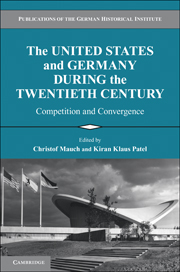Book contents
- Frontmatter
- Contents
- Contributors
- Acknowledgments
- 1 Modernities: Competition versus Convergence
- 2 Empires: Might and Myopia
- 3 Religion: Belief and Power
- 4 Law: Constitutionalism and Culture
- 5 Welfare: Entitlement and Exclusion
- 6 Immigration: Myth versus Struggles
- 7 Masses: Mobilization versus Manipulation
- 8 Market: Consumption and Commerce
- 9 Authority: Schools and Military
- 10 Gender: Equality and Differences
- 11 Environment: Conservation versus Exploitation
- 12 Film and Television
- 13 Education: Universities and Research
- 14 Media: Government versus Market
- Index
13 - Education: Universities and Research
Published online by Cambridge University Press: 12 October 2018
- Frontmatter
- Contents
- Contributors
- Acknowledgments
- 1 Modernities: Competition versus Convergence
- 2 Empires: Might and Myopia
- 3 Religion: Belief and Power
- 4 Law: Constitutionalism and Culture
- 5 Welfare: Entitlement and Exclusion
- 6 Immigration: Myth versus Struggles
- 7 Masses: Mobilization versus Manipulation
- 8 Market: Consumption and Commerce
- 9 Authority: Schools and Military
- 10 Gender: Equality and Differences
- 11 Environment: Conservation versus Exploitation
- 12 Film and Television
- 13 Education: Universities and Research
- 14 Media: Government versus Market
- Index
Summary
At the beginning of the twenty-first century, the United States is the world's undisputed leader in higher education and scientific research. Universities such as Harvard, Yale, and Stanford are synonymous with academic excellence. Students and researchers from all over the world flock to American universities. In the natural and social sciences, English is the lingua franca of scholarly discourse, and when the Swedish Nobel Prize committee makes its yearly announcements, the question is not if but how many Americans will be among the winners.
A century ago, however, American higher education was widely viewed as inferior to its European and, most notably, its German counterparts. Research opportunities were limited, and original American contributions to science and scholarship were rare. Over the course of the nineteenth century, about ten thousand American students spent time at German universities with academics who were the leaders in their fields.
At the same time, reform initiatives in the United States, were transforming small colleges established in the colonial period, improving state universities in the Midwest and West, and supplementing the system with private research universities. American reformers of higher education looked to Germany for inspiration – or at least referred to Berlin, Göttingen, and Heidelberg as role models to advance their own ideas. Yet, by the beginning of the twenty-first century, the tide had turned. In a reversal of roles, German academics, politicians, and the media looked to America for models of reform in the hope of creating a “German Harvard.”
Even more so than higher education in general, science is, by its very nature, characterized by a transnational exchange of questions, ideas, and people, but there has always been a special dimension to the German–American scientific relationship. Over the course of a century, that relationship was marked by mutual admiration, cooperation, rivalry, and, finally, voluntary and forced exchange.
Nevertheless, there are distinct national characteristics of science and education in both countries, deeply embedded in their social, political, and intellectual traditions. The organization of universities and research institutes, the selection of students, academic career paths, the level of state and private funding, the overall image of science and technology, and many other features remain different in Germany and the United States.
- Type
- Chapter
- Information
- The United States and Germany during the Twentieth Centurycompetition and convergence, pp. 211 - 226Publisher: Cambridge University PressPrint publication year: 2010

